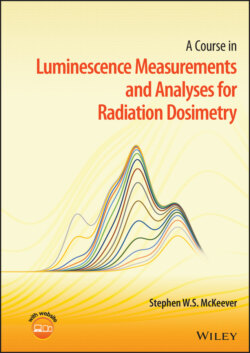Читать книгу A Course in Luminescence Measurements and Analyses for Radiation Dosimetry - Stephen W. S. McKeever - Страница 20
1.2.3 Related Processes
ОглавлениеThermoluminescence is one of a family of thermally stimulated phenomena that include:
Thermoluminescence (TL);
Thermally Stimulated Conductivity (or Current) (TSC);
Thermally Stimulated Capacitance (TSCap);
Deep Level Transient Spectroscopy (DLTS);
Thermally Stimulated Exo-Electron Emissions (TSEE).
Two additional and related phenomena should be added:
Phosphorescence;
Radioluminescence.
These have been described collectively in several text books (Bräunlich 1979; Chen and Kirsh 1981; Chen and McKeever 1997).
Similarly, Optically Stimulated Luminescence is one of a family of phenomena, including:
Optically Stimulated Luminescence (OSL);
Photoconductivity (PC);
Optically Stimulated Exo-Electron Emission (OSEE).
As already noted, RPL does not involve ionization of the localized electrons from their trapping states and can be placed alongside other phenomena, including:
Radiophotoluminescence (RPL);
Electron Paramagnetic Resonance (EPR), also called Electron Spin Resonance (ESR);
Photoluminescence (PL).
All of the above phenomena, except PL, require the initial absorption of energy from an external radiation field before the signal (TL, OSL, RPL, EPR, DLTS, etc.) can be observed. The radiation energy must be sufficiently high to cause ionization within the material – i.e. the creation of free electrons and holes. Photoluminescence is an intrinsic property of the material; that is, it may be observed before irradiation and is not created by it. Ionization is not required. (Photoluminescence can be an interference signal in both RPL and OSL.)
The differences between the phenomena are illustrated schematically in Figure 1.4. Here is represented the energy band diagram previously discussed for an insulator or semiconductor. Ionization by the radiation creates free electrons and holes that may be subsequently trapped at electron and hole localized states. Stimulation (heat or light) induces recombination of the electrons and holes. (Note: We can describe these phenomena in terms of releasing trapped electrons to recombine with holes, or vice-versa. In this description, for ease of explanation, the discussion is limited to releasing electrons to recombine with holes.) Production of TL or OSL only occurs when a portion of the energy released during the electron-hole recombination is radiative. Thus, the TL and OSL signals include information about both the trap and the recombination center. Both are required for TL and OSL to be observed.
Figure 1.4 Schematic diagram illustrating the differences between several thermally and optically stimulated phenomena. Only TL and OSL contain information about both the trap and the recombination center.
Phosphorescence is in fact an unstable form of TL in which the electrons are trapped in the localized energy levels for short periods of time. If the traps are characterized by a small energy barrier then trapped charge can be thermally stimulated even at room temperature, leading to recombination and therefore luminescence emission. Similarly, radioluminescence (RL) results when electrons excited to the conduction band recombine with holes localized in hole traps, without the step of becoming trapped themselves. Emission of RL occurs during the irradiation and decays quickly after the cessation of the radiation, on a time frame governed by the recombination lifetime of the free electrons in the conduction band. In practice, both RL and phosphorescence can be observed during irradiation and the timescale for the decay of the luminescence after the radiation ends is then governed by several different lifetimes, including the recombination lifetime and the trapping lifetime of the electrons in the electron traps. The radioluminescence signal contains information about the recombination centers, whereas the phosphorescence signal includes information about both the traps and recombination centers.
In contrast to TL and OSL, TSC or PC require only the stimulated release of the trapped electrons to the conduction band. The free electrons now have the opportunity to participate in conductivity if an external electric field is applied. Thus, TSC and PC signals hold information about the traps only, not the recombination centers.
Similarly, DLTS and TSCap also monitor the release of electrons from traps, but in these cases the change in the electrical capacitance of the system is measured. Again, the signals contain no information about the recombination centers. Likewise, for TSEE and OSEE, which detect the thermally or optically stimulated emission of energetic exo-electrons from the material.
Electron paramagnetic resonance detects the trapped electrons (or holes) when the charges are localized at the defects, giving rise to an unpaired electron spin. Release of the charge from the traps is not required.
Photoluminescence occurs when electrons in a defect are raised to an excited state, but are not ionized. If relaxation to the ground state is radiative, luminescence (PL) results. If photoluminescence is observed before irradiation of the material, it is simply called PL. However, if irradiation is needed before PL is observed, the term used is RPL (radiophotoluminescence) – that is, PL from a defect that is created by the irradiation. An example helps to understand the distinction. In alkali halides, halide ion vacancies, or F-centers, are produced during irradiation. F-centers consist of trapped electrons localized by halide ion vacancies. At high enough doses, the concentration of F-centers is such that they cluster together to form F2-, F3-centers, etc. These higher-order clusters of F-centers produce photoluminescence when stimulated at the appropriate wavelength. Without radiation, however, these centers do not exist and so the PL signal from them is correctly termed RPL. In contrast, luminescent materials may be doped with tri-valent rare-earth (RE) ions, RE3+. The 4f-electrons in such ions may be raised to excited states when stimulated with the right wavelength, and relaxation produces luminescence at wavelengths characteristic of the ion. Such signals are intrinsic to the phosphor, that is, they are not an effect of the absorption of radiation energy. Such signals are correctly called PL.
